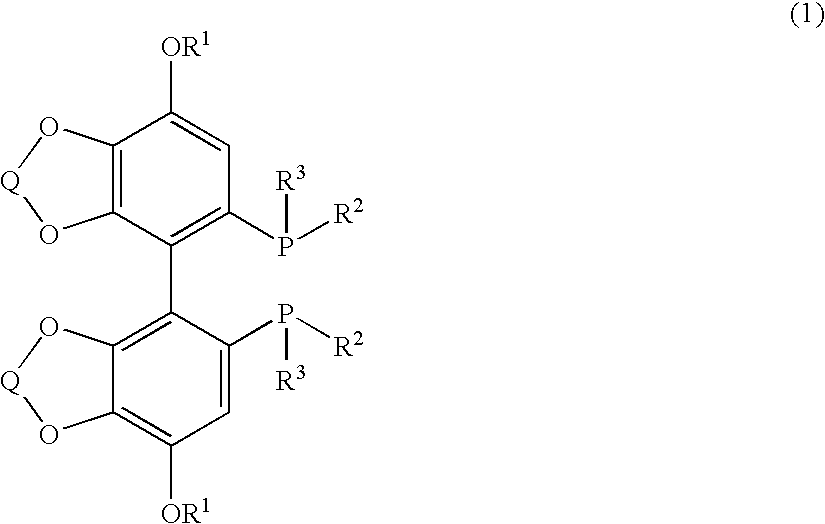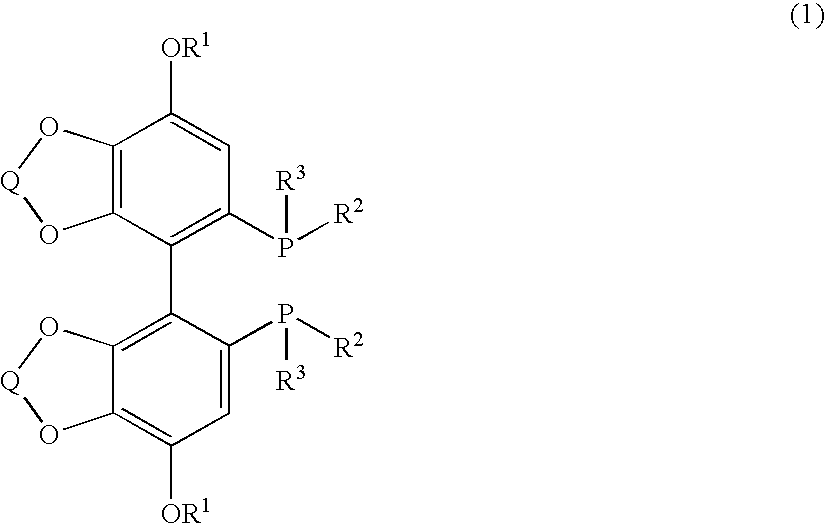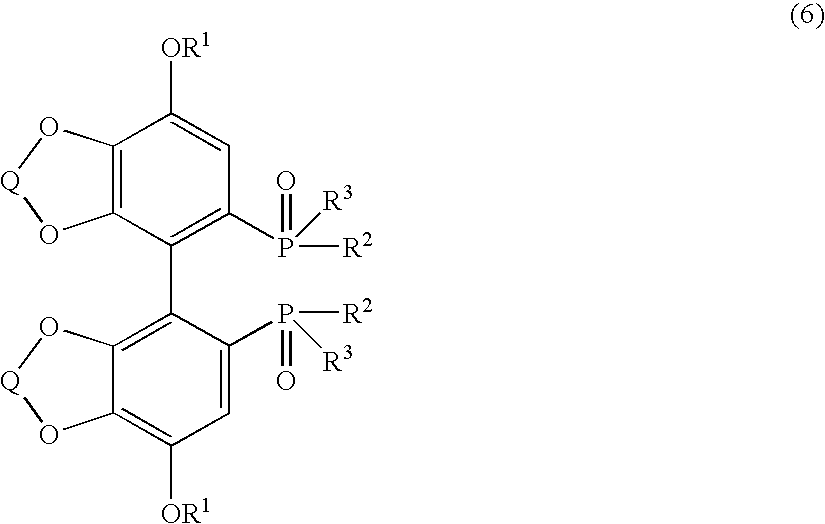Substituted optically active disphosphine compound
a technology of optically active disphosphine and compound, which is applied in the field of new diphosphine compound, can solve the problems of difficult industrial use and complicated synthesis route of both ligands, and achieve the effect of high yield and high asymmetry yield
- Summary
- Abstract
- Description
- Claims
- Application Information
AI Technical Summary
Benefits of technology
Problems solved by technology
Method used
Image
Examples
example 1
Synthesis of (+)-[4,4′-bis(7-methoxy-1,3-benzodioxol)]-5-diyl-diphenylphosphine ((+)-SEGPHOS-4-MeO)
(1) Synthesis of (7-methoxy-1,3-benzodioxol)-5-yl-diphenylphosphine oxide
[0347] To 0.27 g (11.1 mmol) of magnesium piece in a three-necked flask was added 2 mL of tetrahydrofuran (hereinafter, referred to as THF) after replacing with nitrogen. A mixed solution of 2.34 g of 5-bromo-7-methoxy-1,3-benzodioxol and 10 mL of THF was added dropwise to the resultant solution with stirring at 20° C. to 32° C. for 2 hours. After stirring further for 1.5 hours at room temperature, a mixed solution of 2.63 g of diphenylphosphonic chloride and 6 mL of THF was added dropwise to the resultant solution at 23° C. to 38° C. for 1 hour, followed by stirring at 40° C. for 2 hours. And then, the reaction mixture was poured slowly under cooling with ice to 11 mL of 1-N hydrochloric acid followed by stirring for 30 minutes. The reaction product was extracted 2 times with 20 mL of dichloromethane and then w...
example 2
Preparation of [RuCl(p-cymene)((+)-SEGPHOS-4-MeO)]Cl
[0359] Into a 20 mL Schlenk flask was put 100 mg (0.15 mmol) of (+)-SEGPHOS-4-MeO obtained in Example 1 and added 4 mL of ethanol, 4 mL of dichloromethane and 43.5 mg of [RuCl2(p-cymene)]2 after replacing with nitrogen. And then, the reaction is carried out with stirring at 50° C. for 3 hours. After evaporating off the solvent under reduced pressure, the residue was dried under vacuum to give 140 mg of orange yellow-colored solid of the title compound.
[0360]31P-NMR (CDCl3): d 26.4(d, J=62.1 Hz), 41.5(d, J=62.1 Hz).
example 3
Preparation of [Me2NH2][{RuCl((+)-SEGPHOS-4-MeO)}2(μ-Cl)3]
[0361] After replacing with nitrogen, 4 mL of 1,4-dioxane was added to a mixture of 140 mg (0.15 mmol) of [RuCl(p-cymene)((+)-SEGPHOS-4-MeO)]Cl obtained in Example 2 and 13.9 mg of dimethylamine hydrochloride in a 30 mL Schlenk flask, and then the reaction is carried out with stirring at 115° C. for 16 hours. The excess dimethylamine hydrochloride was removed by filtration from the reaction mixture under nitrogen gas, and the solvent was removed by evaporation under reduced pressure from the filtrate. The residue was dried under vacuum to give 125 mg of brown-colored solid of the title compound.
[0362]31P-NMR (CDCl3): d 50.7(d, J=37.5 Hz), 51.5(d, J=38.9 Hz).
PUM
 Login to view more
Login to view more Abstract
Description
Claims
Application Information
 Login to view more
Login to view more - R&D Engineer
- R&D Manager
- IP Professional
- Industry Leading Data Capabilities
- Powerful AI technology
- Patent DNA Extraction
Browse by: Latest US Patents, China's latest patents, Technical Efficacy Thesaurus, Application Domain, Technology Topic.
© 2024 PatSnap. All rights reserved.Legal|Privacy policy|Modern Slavery Act Transparency Statement|Sitemap



